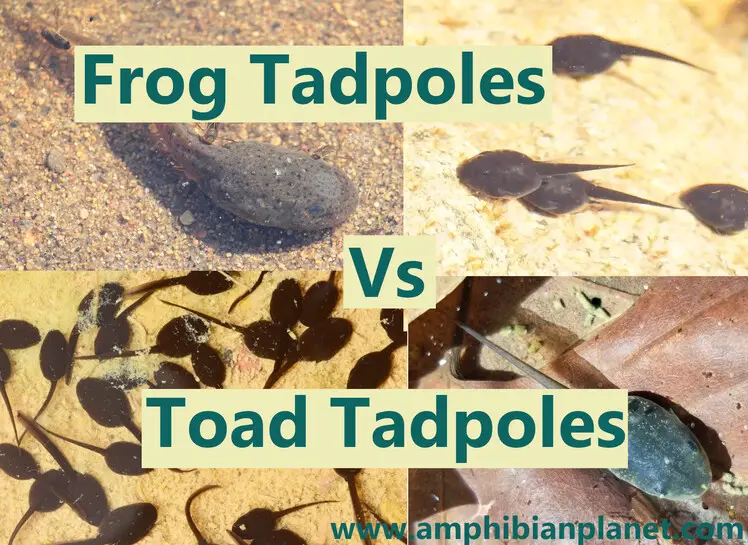Frogs and toads have many things in common. They are both amphibians in the order Anura, which means “without a tail” in Ancient Greek. They both lay their eggs in water and their tadpoles look very similar.
Frog tadpoles tend to be longer and slimmer than toad tadpoles, which tend to be short and chunky. Apart from these differences, frog and toad tadpoles can be difficult to tell apart. They have more similarities than they have differences.
The easiest way of distinguishing frog and toad tadpoles is to learn how to visually identify the tadpoles of different frog and toad species.
Another good way to ID tadpoles is based on when the adults are breeding. If you find tadpoles outside of the breeding season of a particular frog or toad species, you can rule that species out.
What Frog and Toad Tadpoles Have In Common
Tadpoles are very different from adult frogs and toads; this is because they’re adapted for a fully aquatic life, while adult frogs and toads are adapted for a semi-aquatic, or mostly terrestrial life (depending on the species).
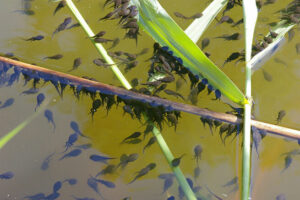
When first hatched, both frog and toad tadpoles tadpoles have visible external gills, often in pairs, on either side of their heads. They use these gills to breathe in the water, just like fish.
They have no limbs and swim through water via undulating movements of a long boneless tail fin. Like fish, tadpoles have a lateral line organ, which runs along each side of their body and tail, through which they sense movements in water.
When tadpoles reach the midway point of their development, opercular folds grow backward from the hyoid arch of each side covering the external gills and gill slits.
In this way, a gill cover known as an “operculum” is formed enclosing the external gills and gill slits – turning the external gills into internal gills. These internal gills are vented by ventrolateral openings, known as spiracles.
Depending on the species, there can be:
- Two spiracles on both sides of the body,
- A single spiracle on the underside near the vent, or
- A single spiracle on the left side of the body
Spiracles are tubular structures leading out of the opercular chamber. Tadpoles eject water through the nostrils and through the spiracles.
Internal Anatomy
Both frog and toad tadpoles primarily feed on algae and detritus in their early stages. Due to this mostly herbivorous diet, both frog and toad tadpoles have very long tightly coiled intestines, that make up more than half of their body mass.
Plants contain cellulose, a compound that is very hard to digest. Because of this, plant matter needs to spend more time in the digestive system. This long intestinal tract gives tadpoles more time to break down the plant matter and absorb as many nutrients as possible.
The intestine takes up about half the space within the tadpole’s body and can be more than ten times longer than the tadpole itself.
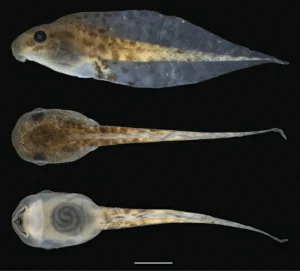
It is also its largest organ and is visible through the translucent belly skin in many tadpole species.
The Differences Between Frog and Toad Tadpoles
Frogs and toads often lay eggs in the same water bodies. While toad eggs are fairly easy to differentiate from frog eggs (toads typically lay eggs in strings while frogs typically lay eggs in masses), this is not the case with the tadpoles.
Frog tadpoles often look very similar to toad tadpoles and can be very difficult for the average person to tell apart. However, there are often a few differences between the two.
- Toad tadpoles tend to be short and chunky while frog tadpoles tend to be longer and slimmer (not always)
- Toad tadpoles tend to have bulky heads, while frog tadpoles have smaller heads (again, not always)
The differences between frog and toad tadpoles can be compared to those of adult frogs and toads – toads are often shorter and chunkier than frogs.
Apart from these differences, frog and toad tadpoles can be difficult to tell apart. They have more similarities than they have differences.

For this reason, the most effective way to distinguish frog and toad tadpoles is to look at mouth parts and teeth rows, since these features are often different in tadpoles of different species.
However, since most people will not be able to do this, an easier way to distinguish tadpoles is to learn how to visually identify the tadpoles of different frog and toad species.
As earlier mentioned, you could also ID tadpoles based on when the adults are breeding.
How to Identify the Tadpoles of 12 Frog Species
As mentioned above, a good way to tell frog and toad tadpoles apart is to learn how to identify the tadpoles of individual frog and toad species.
Here’s how you can identify the tadpoles of 12 frog species:
1. Wood Frog (Lithobates sylvaticus)
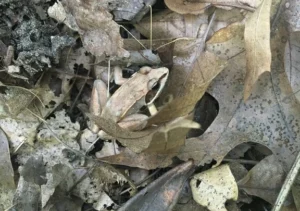
Wood frogs are fairly small frogs found in the northeastern quarter of the United States and throughout most of Canada to central and southern Alaska.
Wood frogs generally lay their eggs in the springtime from March through May, depending on the latitude.
When they first hatch, wood frog tadpoles are very dark in color and about .25 inches long. As they grow, the dorsal color becomes brown and the venter develops gold flecking, giving them a more mottled appearance.
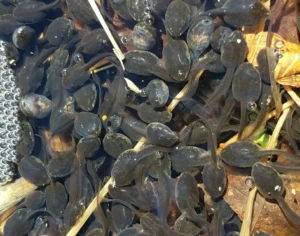
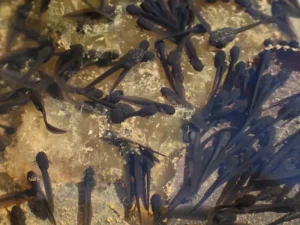
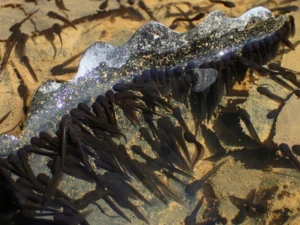
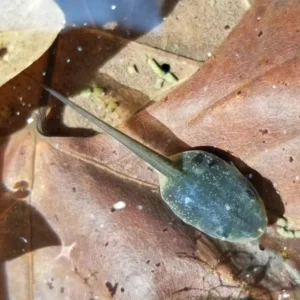
Wood frog tadpoles often school in shallow areas of the pool or float near the surface. Doing this allows them to absorb solar heat, in the relatively cool waters of a vernal pool.
2. Spring Peeper (Pseudacris crucifer)
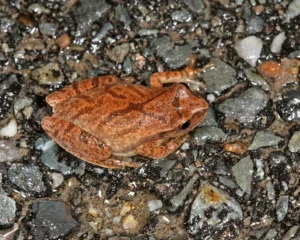
Spring peepers are small, slender tree frogs found throughout much of the eastern part of North America.
They generally lay their eggs in the spring from late March to early May.
Young spring peeper tadpoles are tan/brown with darker mottling and the tail fin is clear. As the tadpoles age, they gain golden or brassy flecking on the body and large dark blotches along the edges of the tail fins.
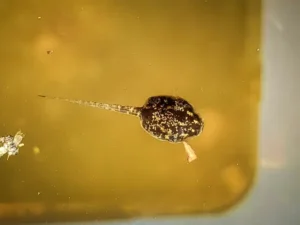
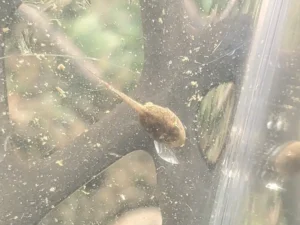

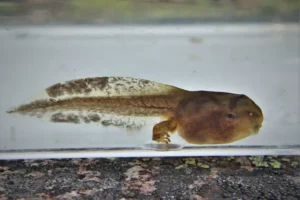
The tadpoles typically grow to 3 to 4 cm in total length before metamorphosis.
3. American Bullfrog (Lithobates catesbeianus)
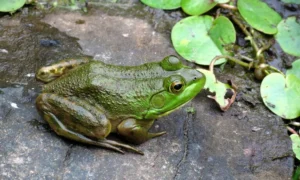
American bullfrogs are the largest frogs found in North America. They can grow to a length of 8 inches or more and weigh up to 1.5 pounds!
American bullfrogs can be found from Nova Scotia, Canada, throughout the continental United States, and as far south as Mexico and Cuba.
Due to this wide distribution, these frogs generally breed at slightly different times of the year, depending on location. In general, they breed from May to July in the north, and February to October in the southern part of their range.
Young American bullfrog tadpoles are black with gold blotches and relatively short tails. As they grow, they develop an olive-green coloration with distinct inky black specks over the dorsal surface.
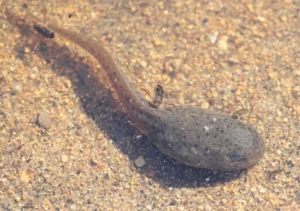
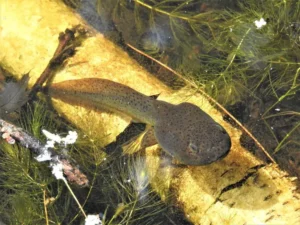
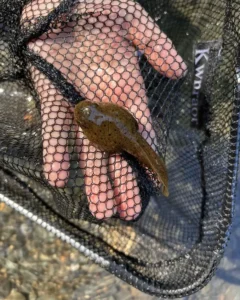
The tadpoles can grow up to 6 inches in length before metamorphosis.
4. Green Frog (Lithobates clamitans)
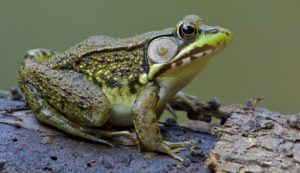
Green frogs are medium-sized frogs (3 – 5 inches in length) found throughout much of the eastern United States as well as southeastern areas of Canada.
They generally breed from April to July but may continue breeding until September in southern portions of their range.
Green frog tadpoles are typically green with small black dots on the dorsal side of their bodies, with tails that are dark green or brown with dark spots. Their bellies are white or cream.
Unlike the tadpoles of most frog species, green frog tadpoles do not have translucent belly skin, and the intestinal coil is not visible.
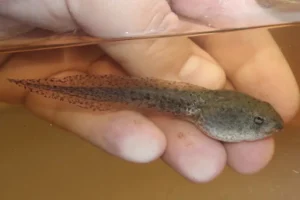
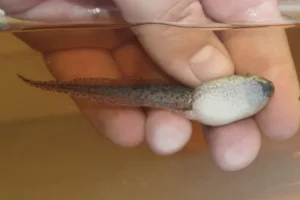
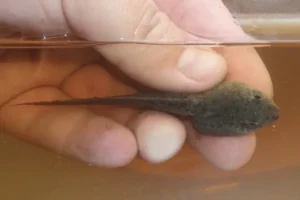
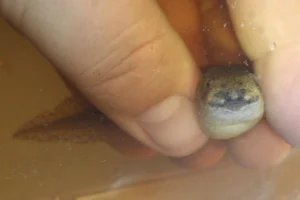
They can grow 3 – 4 inches in length before metamorphosis in length with a body-to-tail ratio of 1:1.8.
5. Northern Leopard Frog (Lithobates pipiens)
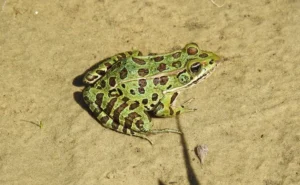
Northern Leopard frogs are small frogs found across much of the Northern part of North America.
They generally breed between March and June.
Leopard frog tadpoles range from light to dark brown or green with small, gold spots and bronze bellies. They have long tails the tail crests are usually a lighter color than the belly.
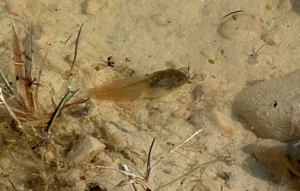
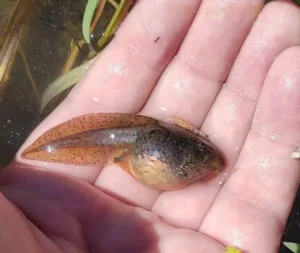
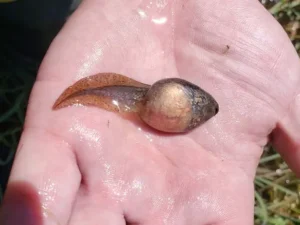
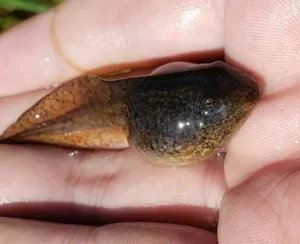
An easy way to distinguish leopard frog tadpoles from those of other frog or toad species is:
- They have dorsal rather than lateral eyes and a white stripe between their nostrils.
6. Pickerel Frog (Lithobates palustris)
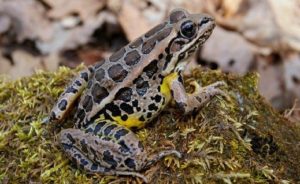
Pickerel frogs are medium-sized frogs found throughout much of the eastern United States and parts of southeastern Canada. These frogs are unique in that they are the only poisonous frogs native to the United States.
Pickerel frogs generally breed in the spring from late March to early May.
Their tadpoles resemble those of leopard frogs; they are greenish in color, with black dots covering the body and tail. The tail crests are clouded, and the underside is cream-colored
Pickerel frog tadpoles can grow 7.6cm before metamorphosis.
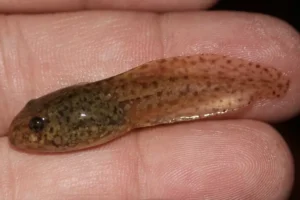
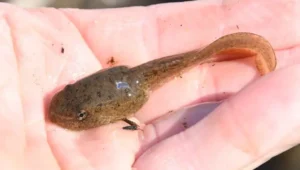
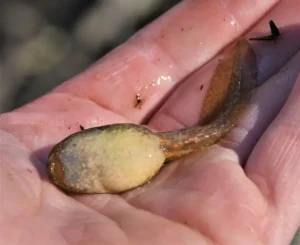
Distinguishing between the tadpoles of pickerel frogs and leopard frogs is extremely difficult based on appearance alone. They can only be effectively distinguished by examining their tooth ridges.
7. Gray Tree Frog (Dryophytes versicolor)
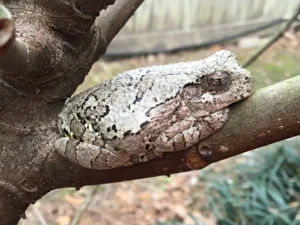
Gray tree frogs are fairly large tree frogs (1– 2 inches in length) native to much of the eastern United States and southeastern Canada. Despite their name, not all gray tree frogs are actually gray.
They vary in coloration from mottled gray or brownish-gray to light green – and they can change color depending on their environment.
Gray tree frogs generally breed in the spring from late April to early August.
Gray tree frog tadpoles have inconsistent coloring, which may include different shades of brown or olive green. The body and tail are patterned with many specks of black and gold – and black blotches may be present around the edge of the tail.
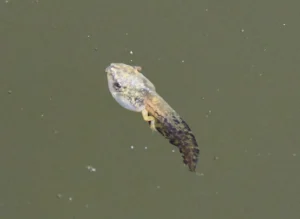
Interestingly, gray tree frog tadpoles can develop a bright red coloration on their tail when they are exposed to predators such as dragonfly larvae.
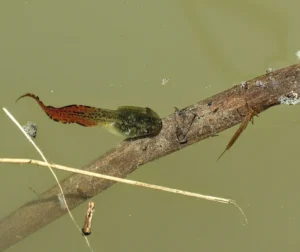
8. Green Tree Frog (Hyla cinerea)
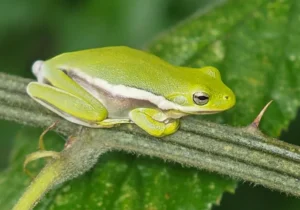
American green tree frogs are small, smooth-skinned frogs found in the central and southeastern United States, from eastern Virginia down to Florida and as far west as Texas.
They generally breed from March to September.
Green tree frog tadpoles have continuous ontogenetic color changes until they reach stages 25 or 26 of their development. At this point, the tadpoles have a green body and a yellow underside.
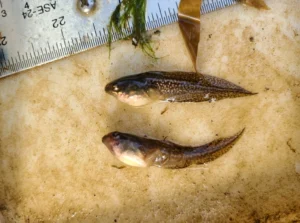
The tail may have distinct yellow orbitonasal stripes, and dark mottling or reticulations.
9. European Common Frog (Rana temporaria)
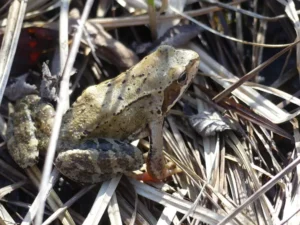
European common, sometimes called common frogs are found throughout most of Europe, except for a few regions.
They generally breed in the spring from March to late June.
Common frog tadpoles are plain black when they hatch but change to a mottled golden brown as they age. This distinguishes them from the plain black common toad (Bufo bufo) tadpoles found in similar habitats.
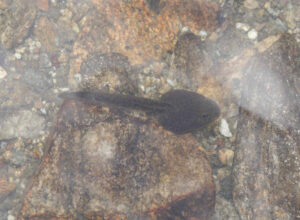
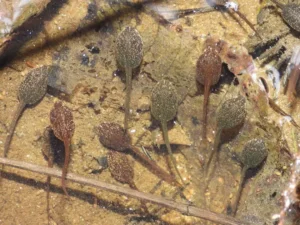
10. Marsh Frog (Pelophylax ridibundus)
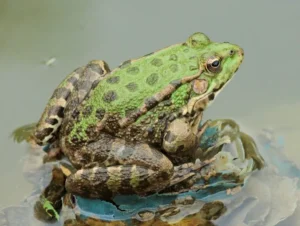
Marsh frogs are Europe’s largest native frogs and are found across Europe and east into Asia. They were introduced to the United Kingdom in the 1930s, and can now be found throughout the southeast of England
They generally breed in the spring, from March, and may continue breeding into the summer.
Marsh frog tadpoles have an olive-green to brownish coloration with small black dots, and cream-to-yellow belies.
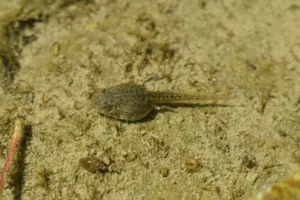
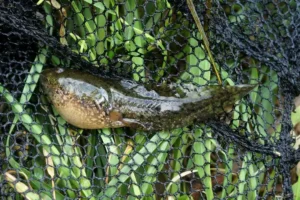
11. Northern Red-legged frog (Rana aurora)
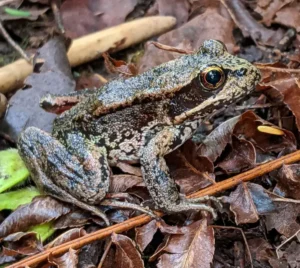
Northern red-legged frogs are medium-sized frogs found along the Pacific coast, west of the Coast and Cascade Mountains from southwestern British Columbia to northern California.
They generally breed in late winter and early spring from January to March.
Northern red-legged frog tadpoles are dark brown when they first hatch, and have a light gold line along the side of the body. However, when seen from a distance, they usually appear black.
They have oval bodies, long tails, and short gills.
As the tadpoles grow, their body color lightens, giving them a tan to dark brown color with scattered clumps of golden flecks. The gold line along the side of the body also disappears.
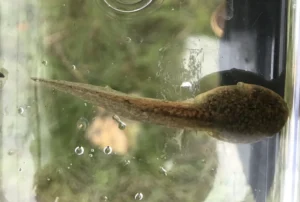
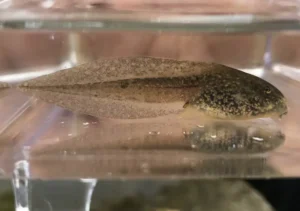
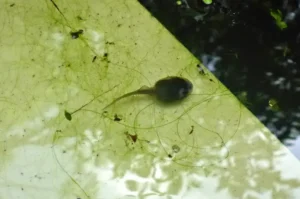
(CC BY-NC 4.0 DEED)
Northern red-legged frog tadpoles grow to 2 to 3 inches in total length before metamorphosis.
12. Pacific Tree Frog (Pseudacris regilla)
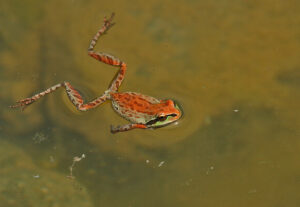
Pacific tree frogs also known as Pacific chorus frogs, are fairly small frogs found on the west coast of North America.
These frogs generally breed in January to mid-May.
Pacific tree frog tadpoles have a brown or olive coloration, usually with black speckling. The underside is whitish.
The tail fin has a high arch that starts mid-way along the back and is rounded at the tip.
When viewed from above, pacific tree frog tadpoles have eyes located on the margins of the head. The eyes, especially in large tadpoles, stick out from the outline of the head.
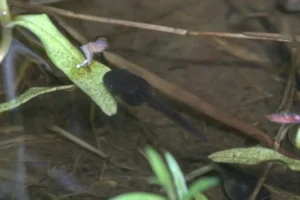
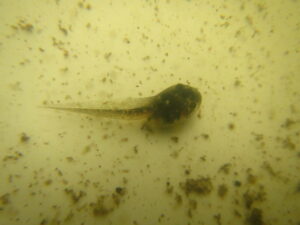
The tadpoles grow to about 2 inches total length before metamorphosis
How to Identify the Tadpoles of 12 Toad Species
Toad tadpoles are often similar to the tadpoles of many frog species. However, they can be distinguished from frog tadpoles by their appearance, and other characteristics.
Here’s how you can identify the tadpoles of 12 toad species:
1. American Toad (Anaxyrus americanus)
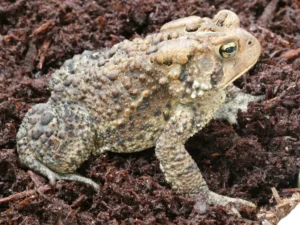
American toads are the most broadly distributed species of true toads (Bufonidae) in North America. They can be found in most areas of eastern Canada and the United States.
They generally breed in the spring, from March through July.
American Toad tadpoles are small, ranging from 0.7 to 1 inch in length. They have a blackish-brown coloration, with a clear fin tail.
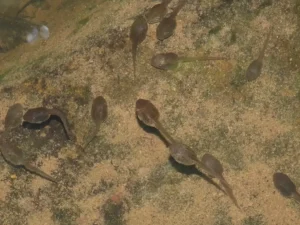
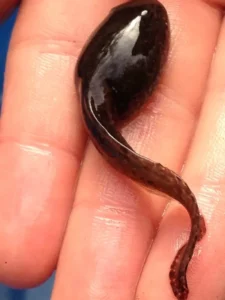
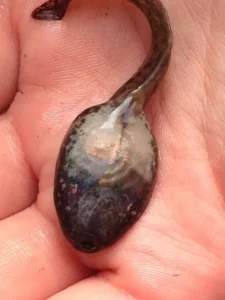
Young American toad tadpoles can easily be recognized by their skinny tails in relation to the size of their bodies.
2. Fowler’s Toad (Anaxyrus fowleri)
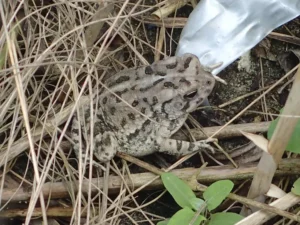
Fowler’s toads are found throughout much of the eastern US, and parts of southeastern Canada.
They generally breed in the spring, from late April to late June.
Fowler’s toad tadpoles range in from 0.4 – 1 inch in length and have dorsal eyes and blunt snouts.
Newly hatched tadpoles appear solid black. However, as they grow, the tadpoles develop a dark brown coloration with light spots on the body and tail.
Fowler’s toad tadpoles can be recognized by their dark tail musculature (which may be lighter on the lower half), and transparent tail fins. The tail fins may sometimes have light specks.
3. Southern Toad (Anaxyrus terrestris)
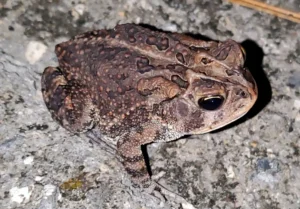
Southern toads are found mainly in the southeastern United States, from southern Virginia to Florida and west into Louisiana.
Southern toads very closely resemble American toads and can be difficult for most people to tell apart. Southern toads are most easily distinguished from American toads by the large knobs on their pronounced cranial crests.
These toads breed from March, through October.
Southern toad tadpoles have a mottled black and gold to green coloration and often have small purplish dots on the dorsal surface.
The underside is also blackish with somewhat purplish, scattered spots
The upper tail fin is faintly spotted, but the lower tail fin is not.
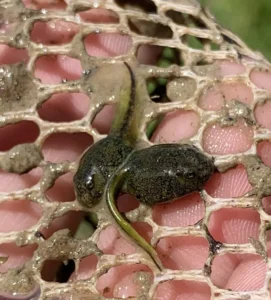
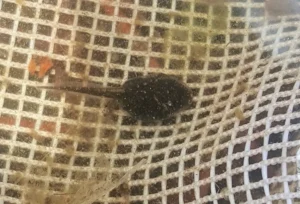
Southern toad tadpoles can grow to about 1 inch in length before metamorphosis but are usually smaller.
4. Western Toad (Anaxyrus boreas)
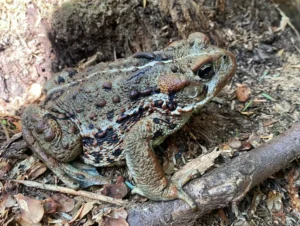
Western toads are found in much of the western parts of North America, from southern Alaska to northern Baja California, Mexico.
They generally breed from February to July.
Western toad tadpoles are black with a clouded tail fin that lacks patterning – when they first hatch.
As they age, they develop a dark brown coloration and varying degrees of fine lighter flecking on the body.
The tail musculature is dark, and the fins are slightly pigmented with the dorsal fin darker than the ventral
Western toad tadpoles have an underside that is slightly paler than the dorsal surface. The fine lighter flecking on older tadpoles gives them a fine golden shimmer over the belly when viewed in bright light.
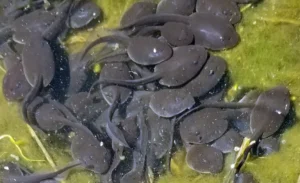
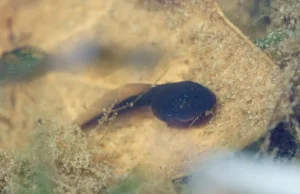
They can grow to about 1 inch in length before metamorphosis.
5. Woodhouse’s Toad (Anaxyrus woodhousii)
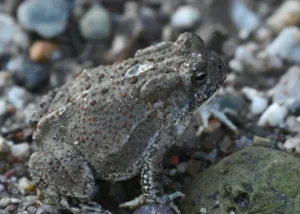
Woodhouse’s toads can be found throughout much of the central and western United States.
They generally breed from March to July.
Woodhouse’s toad tadpoles can be difficult to distinguish from those of the western toad.
They are small (less than one inch in total length), darkly pigmented, and may be covered in small metallic gold flecks. The tail fin is clear and rounded at the tip.
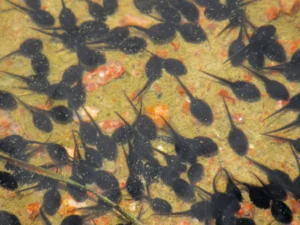
Since the tadpoles of both western and Woodhouse’s toad species are similar, an easy way to distinguish them is: Woodhouse’s toad tadpoles have patches of white and gold pigment on the body and the underside of the tail musculature and the tail fin lacks pigment except for some dark flecking.
Western toad tadpoles, on the other hand, appear uniformly black (fine gold pigmentation on the belly is visible in bright light), the dorsal fin is moderately pigmented, and the ventral fin has little or no pigmentation.
6. European Common Toad (Bufo bufo)
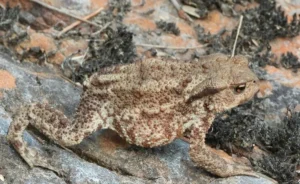
Common toads, sometimes called European common toads are one of the most populous species of amphibians in Europe.
They can be found throughout most of Europe – only absent from Ireland, several Mediterranean islands, and Iceland.
Common toads breed in the spring, from April to July.
Their tadpoles are uniformly blackish in color, and have a gray underside – and often shoal together, like fish.
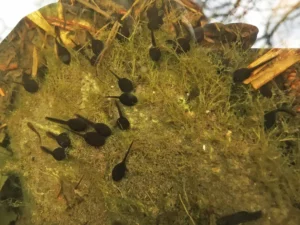
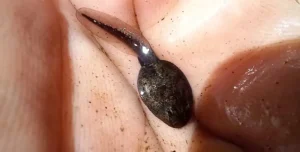
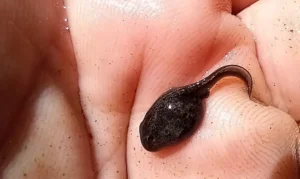
Common toad tadpoles can be distinguished from the tadpoles of other toad or frog species by the fact that the mouth is the same width as the space between the eyes.
This is twice as large as the distance between the nostrils.
7. Natterjack Toad (Epidalea calamita)
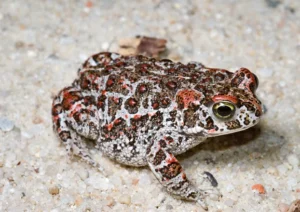
Natterjack toads can be found in the sandy and heathland areas of Europe.
They breed between the end of April and July.
Natterjack toad tadpoles appear similar to those of the common toad. However, they are slightly smaller than common toad tadpoles.
They also have a more rounded snout and bask around the edges of pools but tend not to shoal.
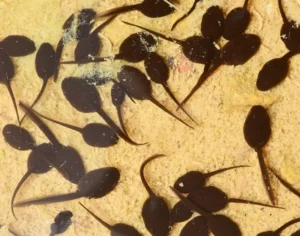
As they begin to develop back legs, a small, white spot may be visible on their chin, growing into a large patch as they develop.
8. Cane Toad (Rhinella marina)
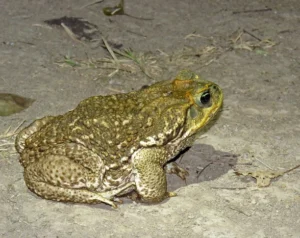
Cane toads (also called marine toads) are native to South and Central America. But they have also been introduced to other countries where they aren’t native, such as Australia, where they have become a significant pest species.
They are also found in areas of Central and South Florida, including Key West and Stock Island, and in an isolated population in Bay County in the panhandle.
Depending on their habitat, Cane toads can breed year-round, following heavy rains.
Cane toad tadpoles have a shiny black coloration on top and a plain dark bluish-grey or black belly.
They have black musculature surrounded by clear tail fins, which makes their tails appear quite slim. The tail is usually one and a half times the length of the body.
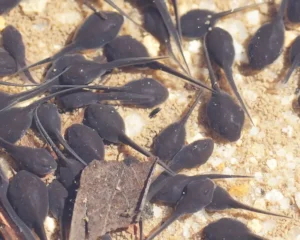
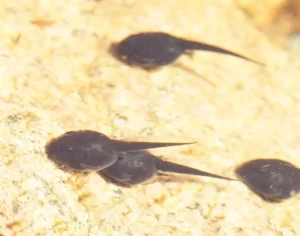
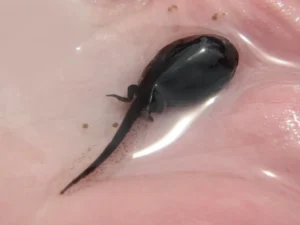
Cane toad tadpoles are small, and only grow to 30mm in length, with the body about 11mm long at most.
9. Yosemite Toad (Anaxyrus canorus)
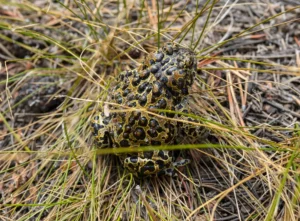
Yosemite toads are found in a small area of the Sierra Nevada Mountains in California and have never been found outside of California.
They breed from May to July.
Yosemite toad tadpoles are small, growing about 0.39–1.46 inches (10–37 millimeters) in length.
They have a jet-black coloration, and unlike many other tadpoles, their intestines are not visible ventrally.
Yosemite toad tadpoles have their eyes set dorsally, which is in contrast to the tadpoles of the Sierran chorus frog (which occurs in the same range) – which have eyes on the top of their head.
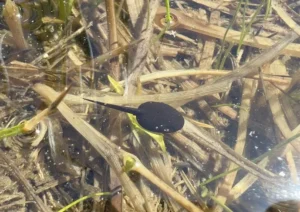
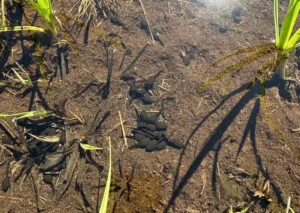
Yosemite toad tadpoles can be easily confused with those of the western toad.
However, in contrast to the western toad, the snout is shorter and blunted in lateral view, the tail fins are mostly opaque, the tail is deepest about halfway down its length, and the tail tip is more rounded.
10. Colorado River Toad (Incilius alvarius)
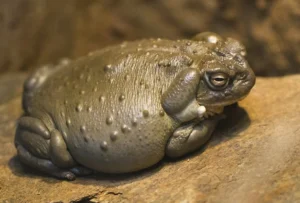
Colorado River toads (also called Sonoran desert toads) are found in and around the Sonoran Desert in California and Arizona south to Mexico.
They breed from May to July.
Colorado River toad tadpoles have a gray or golden brown coloration, which makes them strikingly different from those of related species such as the western toad (Anaxyrus boreas), or Yosemite Toad (Anaxyrus canorus).
11. Red-spotted Toad (Anaxyrus punctatus)
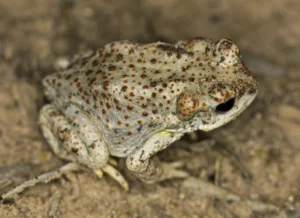
Red-spotted toads can be found throughout the southwestern United States, from parts of southern California to the Central Plains.
They generally breed from March to September.
Red-spotted toad tadpoles have a black or dark brown coloration, with metallic bronze flecks.
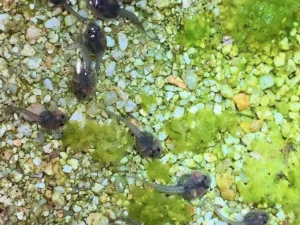
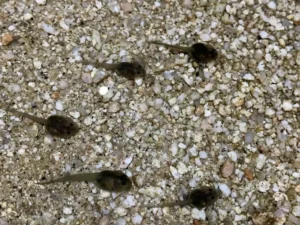
They grow to about 1.5 inches ( 3.8cm) before they go through metamorphosis.
12. Oak Toad (Anaxyrus quercicus)
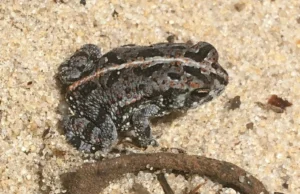
Oak toads can be found in the coastal regions of the southeastern United States, from eastern Louisiana to southeast Virginia and south throughout Florida.
They are the smallest species of toad native to North America, with an adult length of 0.75 to 1.30 inches (19 to 33 mm).
Oak toad tadpoles have a grayish-olive or grape-green coloration on top and a purplish underside. The tail has 6 or 7 black saddle marks.
They grow to a length of 0.71 to 0.76 inches (18 to 19.4 mm) before metamorphosis.
Sources:
Altig, Ronald & Whiles, Matt & TAYLOR, CINDY. (2007). What do tadpoles really eat? Assessing the trophic status of an understudied and imperilled group of consumers in freshwater habitats. Freshwater Biology. 52. 386 – 395. 10.1111/j.1365-2427.2006.01694.x.
Stokeo, W. J. (1980). The Observer’s Book of British Wild Animals. Frederick Warne
Stebbins, Robert C. (1951). Amphibians of western North America. University of California Press
Wright, A. 1932. Life Histories of the Frogs of Okefinokee Swamp, Georgia: North American Salientia (Anura) No. 2. United States: Cornell University Press.

